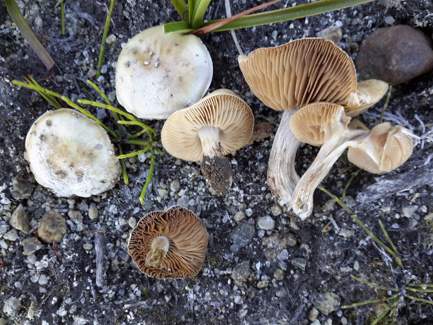 Hebeloma arcticum (Photo: H. Knudsen)
Hebeloma arcticum (Photo: H. Knudsen)Taxonomy
Full name: Hebeloma arcticum Beker & U. Eberh., MycoKeys 79: 83 (2021)Genus: Hebeloma
Section: Denudata
Subsection: Crustuliniformia
Types: GREENLAND: W, Sisimiut, at the bridge on the road to the airport (approx. 66.9443°N, 53.6704°W, alt. approx. 0 m a.s.l.) in arctic tundra, 14 Aug. 2016, H. Knudsen (16.119) (Holotype. herbarium acc. no. C-F-104149, HJB17673).
- arrow_drop_downarrow_drop_upEtymologyarcticus (adj. Latin), meaning the arctic, to emphasize the habitat within which this mushroom has been discovered.
- arrow_drop_downarrow_drop_upDiagnosisFavoring arctic type habitats with many cheilocystidia clavate-stipitate and rather strongly dextrinoid but indistinctly ornamented spores.
References
Description
- arrow_drop_downarrow_drop_upThresholds
Description of Hebeloma arcticum based on 11 collections
- arrow_drop_downarrow_drop_upMacroscopic descriptionPileus: (9) 12–29 (38) mm diameter; shape often strongly umbonate, occasionally convex, umbonate or broadly umbonate; characters Not recorded; margin characters eroded; viscosity tacky when moist; colour variation two color; colour at centre ochraceous.
Lamellae: attachment emarginate; maximum depth 3–4 mm; number of complete lamellae 39–44; presence of tears often visible with x10 lens, occasionally absent; white fimbriate edge occasionally present, weak or very strong.
Cortina presence: no.
Stipe: (8) 13–44 (60) x (1) 2–7 (9) {median} x (1) 2–7 (9) {basal} mm; stipe Q 4.5–8.0; base shape cylindrical, occasionally clavate; floccosity occasionally fibrillose, weakly floccose, pruinose at apex, tomentose or velute; rooting no; thick rhizoids at base absent;
Context: Texture firm; stipe interior hollow; stipe flesh discolouring variable; slenderness measure 4.3–14.6; smell often raphanoid, occasionally earthy; taste mild where recorded.
Spore deposit colour: clay-buff.
Exsiccata characters: Not recorded.
- arrow_drop_downarrow_drop_upMicroscopic descriptionSpores: shape usually amygdaloid, ellipsoid or ovoid; colour in microscope often brown yellow, occasionally yellow; guttules often yes, occasionally no. papilla usually no, rarely weak; Spore Code: O1; P0; D2 D3.
Basidia: (20) 22–37 x 6–10 μm; ave. Q 3.0–3.7; spore arrangement 4 spored;
Cheilocystidia: main shape clavate-lageniform or clavate-ventricose, usually clavate-stipitate, often gently clavate, rarely capitate-stipitate or clavate; special features observed often apical thickening or median thickening, occasionally septa, branching or clamped septa, rarely many collapsed in exsiccata; cheilocystidia ratios: A/M = 1.48–2.25; A/B = 1.18–1.96; B/M = 1.02–1.42.
Pleurocystidia: none seen.
Ixocutis: epicutis thickness (measured from exsiccata) up to 90 μm; ixocutis hyphae width up to 6 μm; ixocutis hyphae encrustation no; shape of trama elements beneath subcutis isodiametric, often ellipsoid or thickly sausage-shaped up to 18 μm wide.
Caulocystidia: Similar to cheilocystidia but larger, up to 90 μm.
- arrow_drop_downarrow_drop_upSpore measurements
- arrow_drop_downarrow_drop_upCheilocystidia measurements
- arrow_drop_downarrow_drop_upHabitat and distributionHebeloma arcticum's preferred habitat appears to be arctic tundra. Where only one possible associate was recorded, the most commonly recorded associate was Salix (87.5%) but Betula (12.5%) were also recorded. In these cases the most commonly recorded families were Salicaceae (83.3%) and Betulaceae (16.7%). Overall the most commonly recorded families are Salicaceae (90.0%), Betulaceae (30.0%) and Polygonaceae (20.0%) No growth habit has been recorded.
According to our current data, the species is found on multiple continents with collections found in Northern America (72.7%), Temperate Asia (18.2%) and Europe (9.1%). On these continents, collections has been found in the WWF biomes The World Wildlife Fund (WWF) have divided the world into 867 terrestrial ecoregions. The ecoregion here is estimated by mapping from the GPS coordinates of the collection using data made available by Dinerstein et al (2017). Use this webtool to explore the ecoregions visually or see a full list of current ecoregions on Wikipedia. tundra (63.6%) and unknown biome (27.3%), specifically including the ecoregions: Kalaallit Nunaat Arctic steppe (45.5%), Unknown region (27.3%) and Yamal-Gydan tundra (18.2%). From collector information, it appears collections have been found in the 4.1 Grassland – Tundra (81.8%) and 5.10 Wetlands (inland) – Tundra wetlands (inc. pools and temporary waters from snowmelt) (18.2%) IUCN habitats We map from the collector's description of the habitat to the International Union for Conservation of Nature (IUCN)'s definition using a standardised set of rules. Please see this page for a full list of IUCN habitats..
Within Northern America all our records are from Subarctic America (Greenland).
Within Temperate Asia all our records are from Siberia (Tyumen).
Within Europe all our records are from the North (Iceland).
- arrow_drop_downarrow_drop_upMolecular resultsHebeloma arcticum is well distinct from related taxa and is in a supported clade with other members of H. subsect. Crustuliniformia, but is not a member of the H. alpinum-complex. The clade of the species is supported by 100% bootstrap in the analysis of three loci), but based on current knowledge, ITS alone is sufficient to recognize the taxon; in the ITS tree calculated prior to concatenation of the data, H. arcticum received 84% bootstrap support.
- arrow_drop_downarrow_drop_upCommentaryThe mainly clavate-stipitate cheilocystidia indicate that this species belongs in H. sect. Denudata and there in H. subsect. Crustuliniformia. Few species of the subsection have almost smooth spores or spores that are rather strongly dextrinoid. The combination of almost smooth and rather strongly dextrinoid spores is unique in this subsection. Molecular results support its placement within this subsection. Within H. sect. Denudata, based on the spore characters, H. arcticum is readily identifiable. To be noted is also the unusual shape of the spores; while many spores are amygdaloid, many others appear more ellipsoid or cylindrical, again uncommon for this section of Hebeloma.
Geographic distribution
Phenology
- arrow_drop_downarrow_drop_upAdditional cited collections